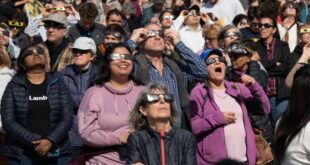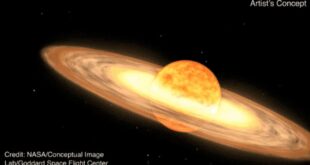Telescope has ‘transformed humanity’s view of the cosmos’: NASA.

Astronomers and fans of its stunning images of deep space are celebrating the James Webb Space Telescope’s first year of operation this week.
One year ago Wednesday, the first image was unveiled ceremoniously at the White House by U.S. President Joe Biden and NASA administrator Bill Nelson.
The $10 billion US telescope is the successor to the aging Hubble Space Telescope, which was launched into orbit in 1990. Both the Hubble and Webb telescopes use a series of curved mirrors instead of lenses to reflect light that is collected by powerful sensors and instruments to produce their hypnotic images.
According to the North Americans Space Agency (NASA), the JWST has a much larger primary mirror than the Hubble, which ultimately lets it absorb more light from further away.
“In just one year, the James Webb Space Telescope has transformed humanity’s view of the cosmos, peering into dust clouds and seeing light from faraway corners of the universe for the very first time.” Nelson said in a release accompanying the newest image from the telescope.
The image of the Rho Ophiuchi cloud complex, the closest star-forming region to Earth at some 390 light-years away, illustrates the power of the telescope.
Here are some of the highlights from the JWST releases over its first year.
(NASA, ESA, CSA, STScI, Webb ERO production team/Handout via Reuters)
The first full-colour image from the Webb telescope, a revolutionary apparatus designed to peer back through the cosmos to the dawn of the universe, shows the galaxy cluster SMACS 0723, known as Webb’s First Deep Field, in a composite made from images at different wavelengths taken with a near-infrared camera and released July 11, 2022.
(Handout/NASA, ESA, CSA, STScI, Webb ERO production team/Reuters)
The Cosmic Cliffs of the Carina Nebula are seen in an image divided horizontally by an undulating line between a cloudscape forming a nebula along the bottom portion and a comparatively clear upper portion, with data from the Webb telescope, released July 12, 2022.
(Handout/NASA, ESA, CSA, STScI, Webb ERO production team/Reuters)
View of M74, otherwise known as the Phantom Galaxy, in an image released Aug. 29, 2022. Webb’s sharp vision reveals delicate filaments of gas and dust in the spiral arms that wind outward from the centre of this image.

(L. Armus/ESA,Webb, NASA & CSA)
Two merging galaxies cavort in this image captured on Nov. 30, 2022. This pair of galaxies, known to astronomers as II ZW 96, is roughly 500 million light-years from Earth and lies in the constellation Delphinus, close to the celestial equator.

(L. Armus/ESA,Webb, NASA & CSA)
An hourglass-shaped, multi-coloured cloud set against the black, starry background of space in this image produced on Nov. 16, 2022. This cloud of dust and gas is illuminated by light from a protostar, a star in the earliest stages of formation.

(NASA, ESA, CSA, STScI)
A combination of images of the iconic Pillars of Creation from two cameras aboard the Webb telescope that frame the universe in its infrared glory. Webb’s near-infrared image was fused with its mid-infrared image, setting this star-forming region ablaze with new details on Nov. 30, 2022.

(Joseph DePasquale, Alyssa Pagan, Anton M. Koekemoer/STScI)
In this image from Sept. 6, 2022, thousands of never-before-seen young stars are pictured in the Tarantula Nebula. The telescope revealed details of the structure and composition of the nebula, as well as dozens of background galaxies.

(NASA, ESA, CSA, STScI, Webb ERO production team)
This image from Aug. 22, 2022, of the planet Jupiter comes from the near-infrared camera (NIRCam), which has three specialized infrared filters that showcase details of the planet. Since infrared light is invisible to the human eye, the light has been mapped onto the visible spectrum.

(NASA, ESA, CSA, Jupiter ERS Team; image processing by Ricardo Hueso (UPV/EHU) and Judy Schmidt)
JWST turned to Saturn in June 2023 to conduct a deep search for new ring structures and faint moons. Saturn itself appears extremely dark at the infrared wavelengths sensed by JWST’s near-infrared camera, as methane gas absorbs almost all of the sunlight falling on the atmosphere. Several very deep Saturn exposures taken together with this image were designed to test JWST’s capacity to detect faint moons around the planet and its bright rings.
ABOUT THE AUTHOR
Staff Photographer
Ben Nelms is an award-winning photojournalist based in Vancouver, B.C.
*****
Credit belongs to : www.cbc.ca
 Atin Ito First Filipino Community Newspaper in Ontario
Atin Ito First Filipino Community Newspaper in Ontario






